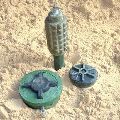Joint clearance of landmines in southern Sudan
NAIROBI, August 10, 2004 (IRIN) — The Sudanese government, aid agencies and the
rebel Sudan People’s Liberation Movement/Army (SPLM/A), have started a
joint operation to clear landmines in the south. The operation is the
first joint exercise since war between the government and the SPLM/A broke
out in 1983.
 Aleu Ayieny Aleu, executive director of the New Sudan Mine Action
Aleu Ayieny Aleu, executive director of the New Sudan Mine Action
Directorate (NSMAD), which is managed by the SPLM/A, told IRIN on Monday
that the landmine clearing operation had started both in SPLM/A and
government-controlled areas. It followed an agreement reached in July in
the Kenyan capital, Nairobi.
“We are working between Lokichoggio, the Kenyan border and Kapoeta County,
eastern Equatoria region,” Aleu said. The government, he added, had also
started similar operations in the north and in the Nuba Mountains.
Salaf al-Din, the Sudanese government humanitarian aid envoy, said that an
awareness campaign would also be started alongside the provision of
assistance to mine victims.
An official from the South African landmine company (MECHAM), told IRIN
that his firm was clearing landmines along roads leading from Lokichoggio
to Kapoeta County. MECHAM is working hand-in-hand with Operation Save
Innocent Lives (OSIL), a south Sudanese NGO.
In its annual report for April 2003 to March 2004, OSIL said it had made
safe an area totalling 906,675 sq. mt and removed 122 anti-personnel
landmines, 24 anti-tank landmines, and 6,726 unexploded ordnances.
The areas that had been cleared of landmines, OSIL added, included roads
and pieces of land in Yei County, Western Equatoria, Magwi and Kapoeta
counties in Eastern Equatoria and the Nuba Mountains region.
“No one knows how many landmines remain uncleared from the ongoing
conflicts. Similarly, the total number of victims is difficult to assess
with any degree of certainty. What is certain is that landmines continue
to claim human victims, livestock and wildlife,” OSIL noted.
It said landmine accidents in southern Sudan were sporadic and most
occurred in forests and remote or insecure areas. In 2003, six people were
killed and 10 injured in Magwi County while in February, one man was blown
up and the other lost one leg in a landmine accident in Yei. At Kauda in
the Nuba Mountains, eight civilians were killed when an OSIL truck hit an
anti-tank mine.
The OSIL said landmines had not only killed, maimed and injured thousands
of individuals in the region each year, but had also affected the social,
economic and environmental infrastructure, including rendering fertile
agricultural land and water points dangerous.
